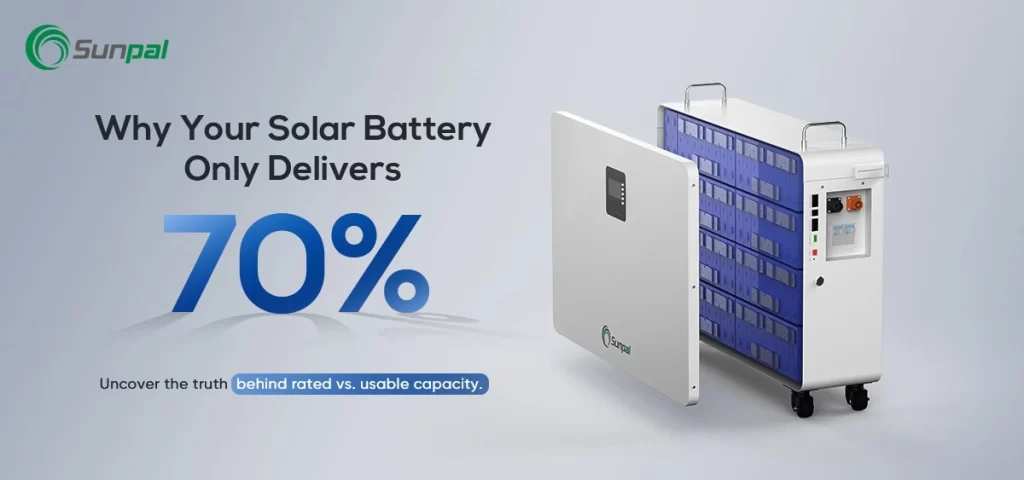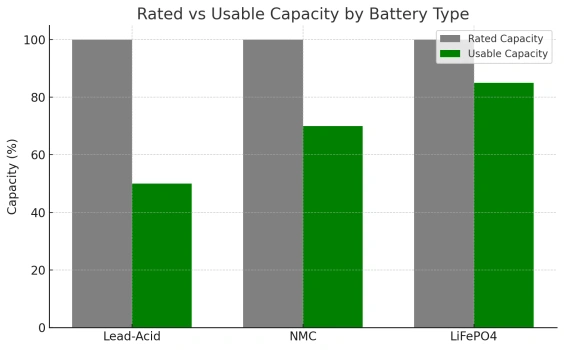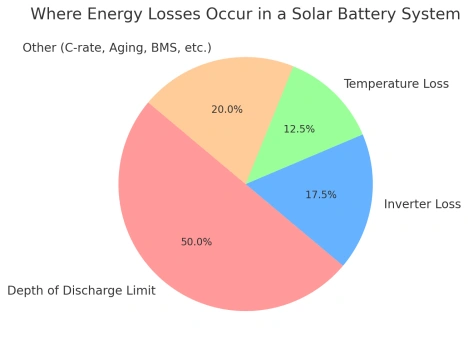
Understanding the Capacity Gap in Solar Energy Storage Systems
A growing number of businesses and homeowners investing in solar energy systems are noticing a perplexing issue: their solar batteries consistently deliver only about 70% of the advertised energy capacity. A 10kWh system, for example, often outputs just 7kWh of usable energy.
Is this a product defect? A technical error? In fact, it's a normal limitation of battery design and system efficiency — and understanding this gap is critical for solar companies, installers, and end users aiming to optimize their investments.
This article explores why this happens, how it impacts your solar performance, and how industry leaders like Sunpal design smarter systems that deliver more usable power.
Rated vs Usable Capacity: What's the Difference?
Every battery has a rated capacity, typically expressed in kilowatt-hours (kWh), which represents the total amount of energy it can theoretically store. However, this number does not account for real-world losses or safety mechanisms that reduce how much of that energy can actually be used.
In practice, this means that even high-end energy storage solutions will never deliver 100% of their rated capacity to the load.
The usable capacity is the portion of the battery that can be safely discharged and converted into usable alternating current (AC) energy. The discrepancy between rated and usable capacity depends on several variables — including battery chemistry, temperature, discharge rates, and inverter efficiency.
Battery Chemistry Matters: A Comparative Look
Different solar battery types offer varying levels of usable capacity. Here's a comparative look at common battery chemistries:

- Lead-Acid Batteries: Usable capacity is typically limited to 50% to avoid permanent damage. These systems are less common in modern solar setups due to low efficiency and shorter lifespan.
- Nickel Manganese Cobalt (NMC) Lithium Batteries: Offer higher energy density and about 70% usable capacity under safe discharge conditions.
- Lithium Iron Phosphate (LiFePO₄ or LFP) Batteries: The preferred chemistry for solar storage, offering up to 85% usable capacity, better thermal stability, and longer cycle life.
As more solar providers shift to LiFePO₄ technology, the gap between rated and usable capacity is narrowing — but not disappearing.
Breaking Down the Losses: Where the Energy Goes
Let's look at the typical causes of energy loss in a 10kWh solar battery system:

1. Depth of Discharge (DoD) Protection
Batteries must retain a safety buffer to avoid over-discharge. Most are configured to stop discharging at around 10–20% remaining capacity. This preserves battery health and prolongs service life.
Loss range: 15% to 25%
2. Inverter Efficiency
Converting DC power stored in batteries to AC for homes and businesses is never 100% efficient. Even top-tier inverters lose 5–10% during this process.
Loss range: 5% to 10%
3. Temperature Impacts
Battery performance drops in extreme temperatures. Without adequate insulation or HVAC control, usable energy decreases significantly.
Loss range: 3% to 8%
4. System Inefficiencies and Aging
Cable resistance, battery management system (BMS) operations, and aging effects also reduce usable energy over time.
Loss range: 5% to 8%
Real-World Example: Output from a 10kWh System
| Energy Stage | Energy (kWh) | Loss (%) |
| Rated Capacity | 10.0 | — |
| After Depth of Discharge Limit | 8.0 | -20% |
| After Inverter Conversion | 7.2 | -10% |
| After Other Losses | ~7.0 | -2.5% |
Final usable capacity: ~7.0 kWh (or 70%)
How Solar Experts Minimize the Loss
Although the energy gap is unavoidable, smart solar energy providers and installers implement strategies to mitigate losses and improve system efficiency.
1. Use High-Efficiency LiFePO₄ Batteries
LiFePO₄ batteries offer superior round-trip efficiency (up to 95%), better thermal behavior, and long service life — making them ideal for demanding solar applications.
2. System Oversizing for DoD Flexibility
Designing the system to operate below 100% load ensures batteries never need to discharge too deeply. This improves both efficiency and longevity.
3. Install High-Efficiency Inverters
Modern hybrid inverters with 97–98% efficiency ratings significantly reduce conversion losses. These also support faster charging and better system monitoring.
4. Climate-Controlled Battery Housing
Thermal regulation systems protect battery cells from environmental temperature swings that degrade performance and reduce available energy.
5. Intelligent Monitoring and BMS Integration
A smart Battery Management System ensures even cell usage, detects imbalances, and allows early detection of inefficiencies. Integrated Energy Management Systems (EMS) further optimize dispatching and charging behavior.
Commercial and Residential Implications
For residential users, underperforming batteries often translate into higher electricity bills and lower ROI. For commercial solar systems, especially in regions with time-of-use tariffs or high peak demand charges, a 20–30% reduction in usable battery capacity can result in significant financial losses.
That's why commercial EPCs, C&I clients, and grid operators need accurate system design, real-world capacity expectations, and reliable energy storage partners.
Sunpal's Strategy for High Usable Energy Delivery
At Sunpal, system design doesn't end at installation — it begins with deep insight into how batteries behave in real conditions.
Here's how we ensure optimal usable energy:
- Custom System Sizing: Every battery bank is sized based on use-case modeling and solar yield forecasting.
- Advanced BMS Architecture: Built-in balancing and diagnostics extend battery life and optimize usable energy output.
- Temperature-Resilient Design: Our systems include thermal insulation or HVAC for installations in extreme climates.
- Real-Time Monitoring: Clients and installers access performance metrics to troubleshoot or adjust system parameters remotely.
- High-Efficiency Components: Only inverters, cells, and control systems with top-tier efficiency ratings are used.
With deployments across Europe, Southeast Asia, and the Americas, Sunpal systems consistently deliver above-industry-average usable energy ratios.
Conclusion: Rethinking Solar Battery Capacity
The myth that a solar battery should always deliver its full rated capacity can lead to mismatched expectations and client dissatisfaction. The truth is more nuanced — but also more manageable.
Understanding and addressing the energy loss factors in battery systems allows companies to deliver optimized solar + storage solutions that maximize energy yield, lifespan, and investment return.
If your energy storage systems are only delivering 60–65% usable capacity, it may be time to upgrade or redesign. And for new projects, integrating the best technology and design principles from the start will pay long-term dividends.
Want to increase the usable energy from your solar storage system? Contact Sunpal technical team today to build a smarter, more efficient solution tailored to your energy goals.
